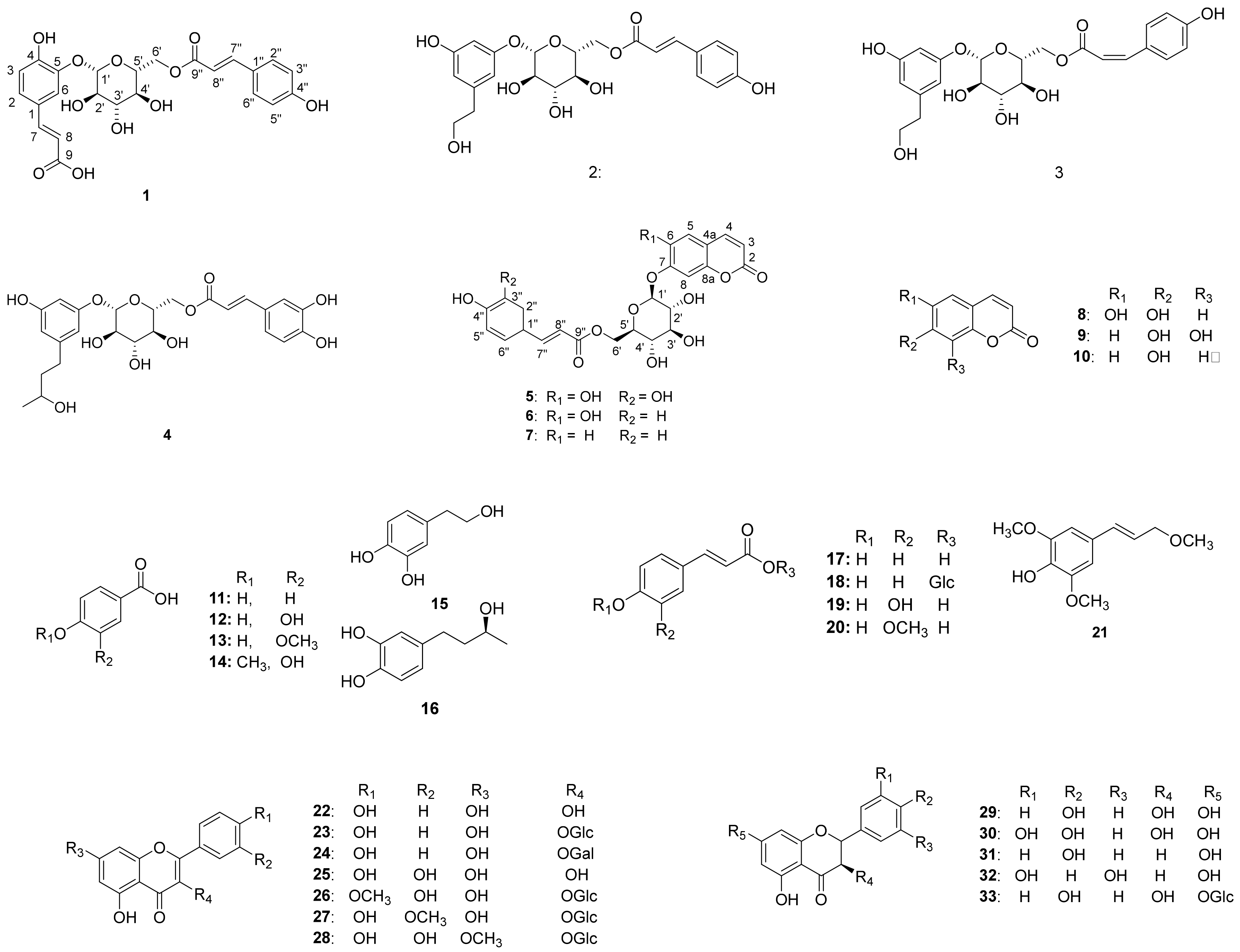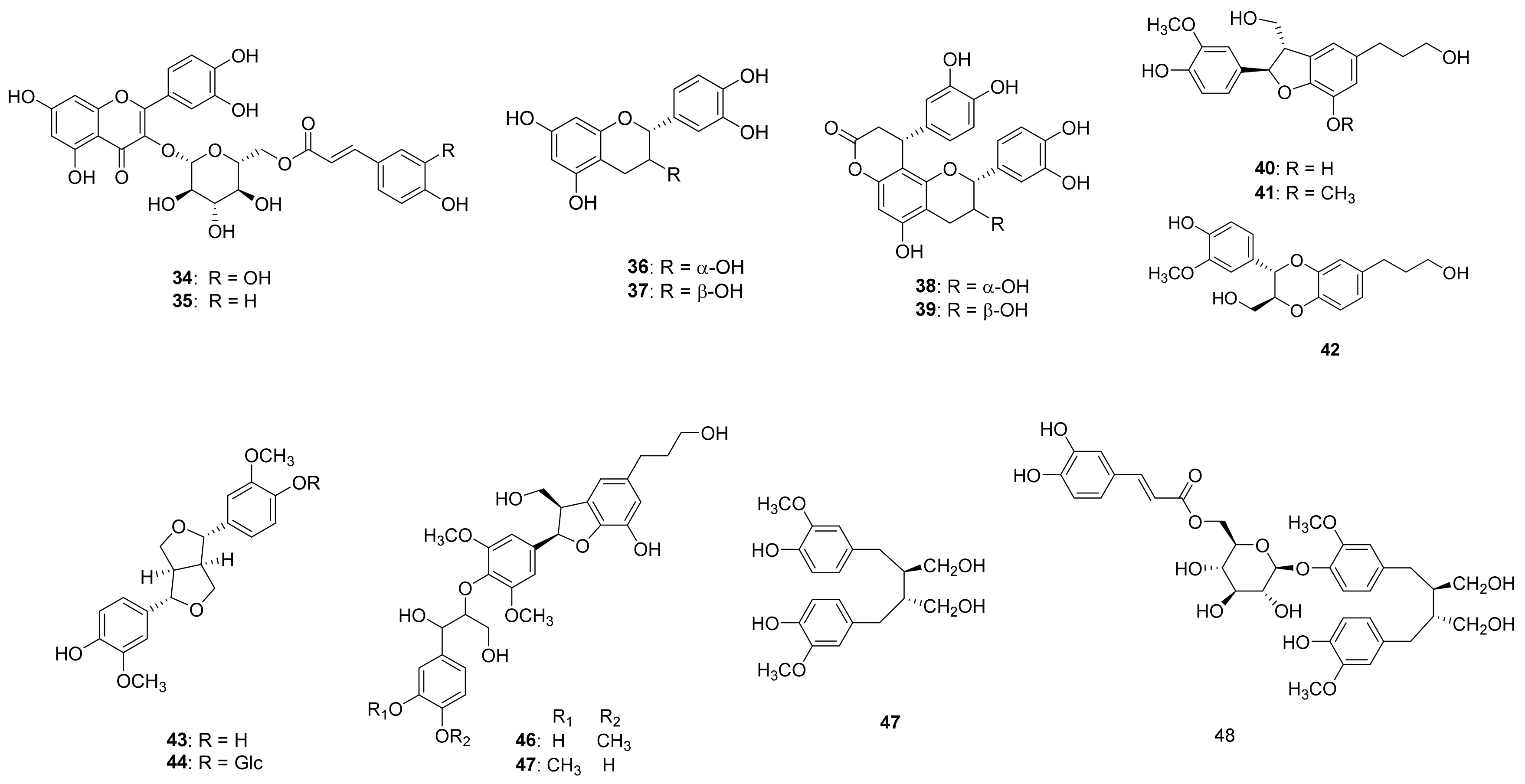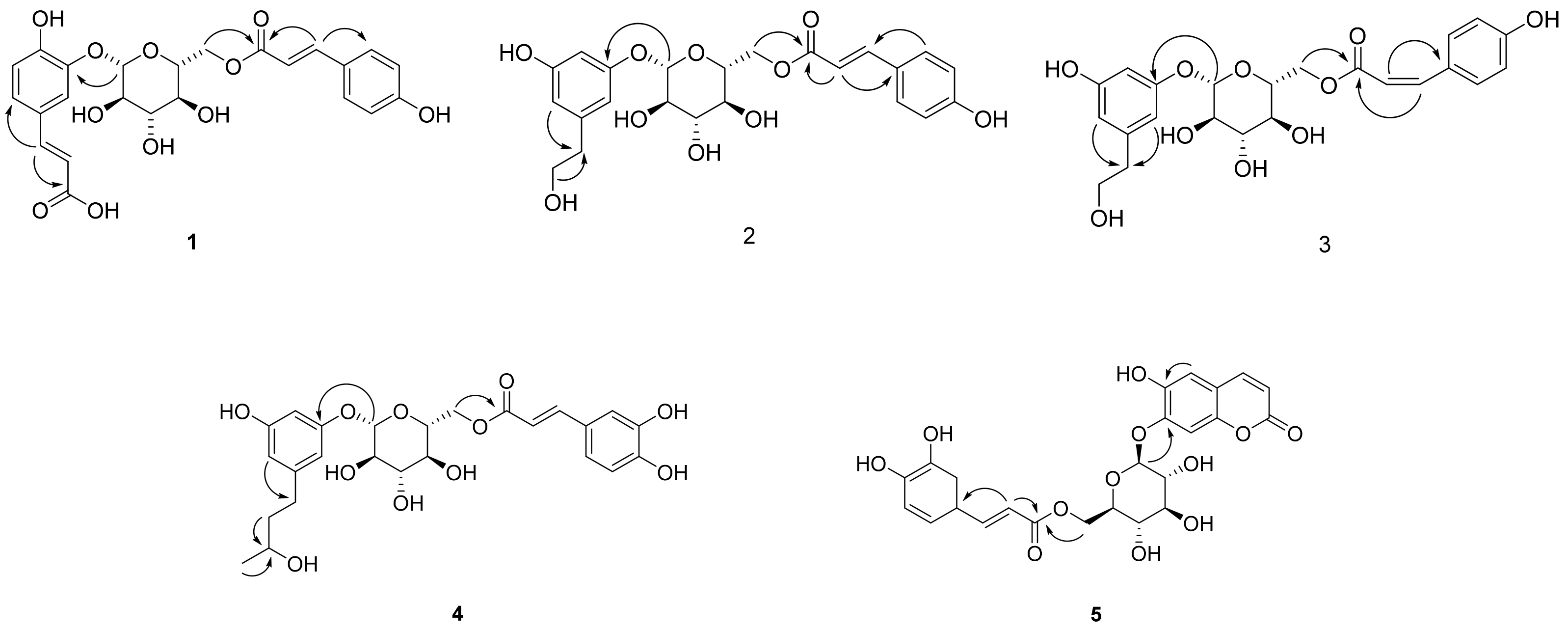Aromatic Constituents from the Leaves of Actinidia arguta with Antioxidant and α-Glucosidase Inhibitory Activity
Abstract
:1. Introduction
2. Materials and Methods
2.1. Plant Material
2.2. General Experimental Procedure
2.3. Extraction and Isolation
2.3.1. Argutoside A (1)
2.3.2. Argutoside B (2)
2.3.3. Argutoside C (3)
2.3.4. Argutoside D (4)
2.3.5. Argutoside E (5)
2.4. Measurement of α-Glucosidase Activity
2.5. Measurement of DPPH Radical Scavenging Activity
2.6. Molecular Docking Studies
3. Results
3.1. Structural Elucidation
3.1.1. Structural Determination of New Compounds
3.1.2. Identification of Known Compounds
3.2. Antioxidant and α-Glucosidase Inhibitory Activity
3.2.1. Antioxidant and α-Glucosidase Inhibitory Activity of Compounds
3.2.2. Molecular Docking Analysis
4. Conclusions
Supplementary Materials
Author Contributions
Funding
Institutional Review Board Statement
Informed Consent Statement
Data Availability Statement
Acknowledgments
Conflicts of Interest
References
- Reuter, S.; Gupta, S.C.; Chaturvedi, M.M.; Aggarwal, B.B. Oxidative stress, inflammation and cancer: How are they linked? Free Radic. Biol. Med. 2010, 49, 1603–1616. [Google Scholar] [CrossRef] [PubMed] [Green Version]
- Butterfield, D.A.; Halliwell, B. Oxidative stress, dysfunctional glucose metabolism and Alzheimer disease. Nat. Rev. Neurosci. 2019, 20, 148–160. [Google Scholar] [CrossRef] [PubMed]
- Yaribeygi, H.; Sathyapalan, T.; Atkin, S.L.; Sahebkar, A. Molecular mechanisms linking oxidative stress and diabetes mellitus. Oxid. Med. Cell Longev. 2020, 2020, 8609213. [Google Scholar] [CrossRef] [PubMed] [Green Version]
- Brownlee, M. The pathobiology of diabetic complications a unifying mechanism. Diabetes 2005, 54, 1615–1625. [Google Scholar] [CrossRef] [PubMed] [Green Version]
- Pitocco, D.; Tesauro, M.; Alessandro, R.; Ghirlanda, G.; Cardillo, C. Oxidative stress in diabetes: Implications for vascular and other complications. Int. J. Mol. Sci. 2013, 14, 21525–21550. [Google Scholar] [CrossRef] [Green Version]
- Giacco, F. Oxidative stress and diabetic complications. Circ. Res. 2011, 107, 1058–1070. [Google Scholar] [CrossRef] [Green Version]
- Yao, D.; Brownlee, M. Hyperglycemia-induced reactive oxygen species increase expression of the receptor for advanced glycation end products (RAGE) and RAGE ligands. Diabetes 2010, 59, 249–255. [Google Scholar] [CrossRef] [Green Version]
- Stefano, G.B.; Challenger, S.; Kream, R.M. Hyperglycemia-associated alterations in cellular signaling and dysregulated mitochondrial bioenergetics in human metabolic disorders. Eur. J. Nutr. 2016, 55, 2339–2345. [Google Scholar] [CrossRef] [Green Version]
- Maritim, A.C.; Sanders, R.A.; Watkins, J.B. Diabetes, oxidative stress, and antioxidants: A review. J. Biochem. Mol. Toxicol. 2003, 17, 24–38. [Google Scholar] [CrossRef]
- Rendra, E.; Riabov, V.; Mossel, D.M.; Sevastyanova, T.; Harmsen, M.C.; Kzhyshkowska, J. Reactive oxygen species (ROS) in macrophage activation and function in diabetes. Immunobiology 2018, 224, 242–253. [Google Scholar] [CrossRef]
- Ghani, U. Re-exploring promising α-glucosidase inhibitors for potential development into oral anti-diabetic drugs: Finding needle in the haystack. Eur. J. Med. Chem. 2015, 103, 133–162. [Google Scholar] [CrossRef]
- Joshi, S.R.; Standl, E.; Tong, N.; Shah, P.; Kalra, S.; Rathod, R. Therapeutic potential of α-glucosidase inhibitors in type 2 diabetes mellitus: An evidence-based review. Expert Opin. Pharmacother. 2015, 16, 1959–1981. [Google Scholar] [CrossRef]
- Umeno, A.; Horie, M.; Murotomi, K.; Nakajima, Y.; Yoshida, Y. Antioxidative and antidiabetic effects of natural polyphenols and isoflavones. Molecules 2016, 30, 708. [Google Scholar] [CrossRef] [Green Version]
- Lin, D.; Xiao, M.; Zhao, J.; Li, Z.; Xing, B.; Li, X.; Kong, M.; Li, L.; Zhang, Q.; Liu, Y.; et al. An Overview of plant phenolic compounds and their importance in human nutrition and management of type 2 diabetes. Molecules 2016, 21, 1374. [Google Scholar] [CrossRef]
- Zhang, P.; Li, T.; Wu, X.; Nice, E.C.; Huang, C.; Zhang, Y. Oxidative stress and diabetes: Antioxidative strategies. Front. Med. 2020, 14, 583–600. [Google Scholar] [CrossRef]
- Latocha, P. The nutritional and health benefits of kiwiberry (Actinidia arguta)—A Review. Plant Foods Hum. Nutr. 2017, 72, 325–334. [Google Scholar] [CrossRef] [Green Version]
- Almeida, D.; Pinto, D.; Santos, J.; Vinha, A.F.; Palmeira, J.; Ferreira, H.N.; Rodrigues, F.; Oliveira, B.P.P. Hardy kiwifruit leaves (Actinidia arguta): An extraordinary source of value-added compounds for food industry. Food Chem. 2018, 259, 113–121. [Google Scholar] [CrossRef]
- Kim, H.Y.; Hwang, K.W.; Park, S.Y. Extracts of Actinidia arguta stems inhibited LPS-induced inflammatory responses through nuclear factor-κB pathway in Raw 264.7 cells. Nutr. Res. 2014, 34, 1008–1016. [Google Scholar] [CrossRef]
- Heo, K.H.; Sun, X.; Shim, D.W.; Kim, M.K.; Koppula, S.; Yu, S.H.; Kim, H.B.; Kim, T.J.; Kang, T.B.; Lee, K.H. Actinidia arguta extract attenuates inflammasome activation: Potential involvement in NLRP3 ubiquitination. J. Ethnopharmacol. 2018, 213, 159–165. [Google Scholar] [CrossRef]
- Kim, G.D.; Lee, J.Y.; Auh, J.H. Metabolomic screening of anti-inflammatory compounds from the leaves of Actinidia arguta (Hardy Kiwi). Foods 2019, 8, 47. [Google Scholar] [CrossRef] [Green Version]
- Ahn, J.H.; Park, Y.; Yeon, S.W.; Jo, Y.H.; Han, Y.K.; Turk, T.; Ryu, S.H.; Hwang, B.Y.; Lee, K.Y.; Lee, M.K. Phenylpropanoid-conjugated triterpenoids from the leaves of Actinidia arguta and their inhibitory activity on α-glucosidase. J. Nat. Prod. 2020, 83, 1416–1423. [Google Scholar] [CrossRef] [PubMed]
- He, R.; Huang, X.; Zhang, Y.; Wu, L.; Nie, H.; Zhou, D.; Liu, B.; Deng, S.; Yang, R.; Huang, S.; et al. Structural characterization and assessment of the cytotoxicity of 2,3-dihydro-1H-indene derivatives and coumarin glucosides from the bark of Streblus indicus. J. Nat. Prod. 2016, 79, 2472–2478. [Google Scholar] [CrossRef] [PubMed]
- Ahn, J.H.; Park, Y.; Jo, Y.H.; Kim, S.B.; Yeon, S.W.; Kim, J.G.; Turk, A.; Song, J.Y.; Kim, Y.; Hwang, B.Y.; et al. Organic acid conjugated phenolic compounds of hardy kiwifruit (Actinidia arguta) and their NF-κB inhibitory activity. Food Chem. 2020, 308, 125666. [Google Scholar] [CrossRef] [PubMed]
- Lin, Y.L.; Wang, W.Y. Chemical constituents of Vernonia patula. Chin. Pharm. J. 2002, 54, 187–192. [Google Scholar]
- Ma, B.; Guo, H.F.; Lou, H.X. A new lignan and two eudesmanes from Lepidozia vitrea. Helvet. Chim. Acta 2007, 90, 58–62. [Google Scholar] [CrossRef]
- Timonen, J.M.; Nieminen, R.M.; Sareila, O.; Goulas, A.; Moilanen, L.J.; Haukka, M.; Vainiotalo, P.; Moilanen, E.; Aulaskari, P.H. Synthesis and anti-inflammatory effects of a series of novel 7-hydroxycoumarin derivatives. Eur. J. Med. Chem. 2011, 46, 3845–3850. [Google Scholar] [CrossRef]
- Ding, H.Y.; Lin, H.C.; Teng, C.M.; Wu, Y.C. Phytochemical and pharmacological studies on Chinese Paeonia species. J. Chin. Chem. Soc. 2000, 47, 381–388. [Google Scholar] [CrossRef]
- Hoang, L.; Joo, G.J.; Kim, W.C.; Jeon, S.Y.; Choi, S.H.; Kim, J.W.; Rhee, I.K.; Hur, J.M.; Song, K.S. Growth inhibitors of lettuce seedings from Bacillus cereus EJ-121. Plant Growth Reg. 2005, 47, 149–154. [Google Scholar] [CrossRef]
- Park, C.H.; Kim, K.H.; Lee, I.K.; Lee, S.Y.; Choi, S.U.; Lee, J.H.; Lee, K.R. Phenolic constituents of Acorus gramineus. Arch. Pharm. Res. 2011, 34, 1289–1296. [Google Scholar] [CrossRef]
- Li, H.Z.; Song, H.J.; Li, H.M.; Pan, Y.Y.; Li, R.T. Characterization of phenolic compounds from Rhododendron alutaceum. Arch. Pharm. Res. 2012, 35, 1887–1893. [Google Scholar] [CrossRef]
- Lee, Y.G.; Cho, J.Y.; Kim, C.M.; Lee, S.H.; Kim, W.S.; Jeon, T.I.; Park, K.H.; Moon, J.H. Coumaroyl quinic acid derivatives and flavonoids from immature pear (Pyrus pyrifolia Nakai) fruit. Food Sci. Biotechnol. 2013, 22, 803–810. [Google Scholar] [CrossRef]
- Prachayasittikul, S.; Suphapong, S.; Worachartcheewan, A.; Lawung, R.; Ruchirawat, S.; Prachayasittikul, V. Bioacitive metabolites from Spilanthes acmella Murr. Molecules 2009, 14, 850–867. [Google Scholar] [CrossRef] [Green Version]
- Bohlmann, F.; Chen, Z.L.; Schuster, A. Aromatic esters from Solidago decurrens. Phytochemstry 1981, 20, 2601–2602. [Google Scholar] [CrossRef]
- Itoh, T.; Ninomiya, M.; Yasuda, M.; Koshikawa, K.; Deyashiki, Y.; Nozawa, Y.; Akao, Y.; Koketsu, M. Inhibitory effects of flavonoids isolated from Fragaria ananassa Duch on IgE-mediated degranulation in rat basophilic leukemia RBL-2H3. Bioorg. Med. Chem. 2009, 17, 5374–5379. [Google Scholar] [CrossRef]
- Han, J.T.; Bang, M.H.; Chun, O.K.; Kim, D.O.; Lee, C.Y.; Baek, N.I. Flavonol glycosides from the aerial parts of Aceriphyllum rossii and their antioxidant activities. Arch. Pharm. Res. 2004, 27, 390–395. [Google Scholar] [CrossRef]
- Jeon, S.H.; Chun, W.J.; Choi, Y.J.; Kwon, Y.S. Cytotoxic constituents from the bark of Salix hulteni. Arch. Pharm. Res. 2008, 31, 978–982. [Google Scholar] [CrossRef]
- Lim, E.K.; Ashford, D.A.; Hou, B.K.; Jackson, R.G.; Bowles, D.J. Arabidopsis glycosyltransferases as biocatalysts in fermentation for regioselective synthesis of diverse quercetin glucosides. Biotechnol. Bioeng. 2004, 87, 623–631. [Google Scholar] [CrossRef]
- Fico, G.; Rodondi, G.; Flamini, G.; Passarella, D.; Tome, F. Comparative phytochemical and morphological analyses of three Italian Primula species. Phytochemistry 2007, 68, 1683–1691. [Google Scholar] [CrossRef]
- He, Z.; Lian, W.; Liu, J.; Zheng, R.; Xu, H.; Du, G.; Liu, A. Isolation, structural characterization and neuraminidase inhibitory activities of polyphenolic constituents from Flos caryophylli. Phytochem. Lett. 2017, 19, 160–167. [Google Scholar] [CrossRef]
- Calzada, F.; Cedillo-Rivera, R.; Mata, R. Antiprotozoal activity of the constituents of Conyza filaginoides. J. Nat. Prod. 2001, 64, 671–673. [Google Scholar] [CrossRef]
- Wan, C.P.; Yuan, T.; Cirello, A.L.; Seeram, N.P. Antioxidant and α-glucosidase inhibitory phenolics isolated from highbush blueberry flowers. Food Chem. 2012, 135, 1929–1937. [Google Scholar] [CrossRef] [PubMed]
- Pizzolatti, M.G.; Venson, A.F.; Junior, A.S.; Smania, E.F.A.; Braz-Filho, R. Two epimeric flavalignans from Trichilia catigua (Meliaceae) with antimicrobial activity. J. Biosci. 2002, 57, 483–488. [Google Scholar] [CrossRef] [PubMed]
- Kim, T.H.; Ito, H.; Hayashi, K.; Hasegawa, T.; Machiguchi, T.; Yoshida, T. Aromatic constituents from the Heartwood of Santalum album L. Chem. Pharm. Bull. 2005, 53, 641–644. [Google Scholar] [CrossRef] [PubMed] [Green Version]
- Fang, J.M.; Lee, C.K.; Cheng, Y.S. Lignans from leaves of Juniperus chinensis. Phytochemistry 1992, 31, 3659–3661. [Google Scholar]
- Kang, W.; Wang, J. In vitro antioxidant properties and in vivo lowering blood lipid of Forsythia suspense leaves. Med. Chem. Res. 2010, 19, 617–628. [Google Scholar] [CrossRef]
- Moon, S.S.; Rahman, A.A.; Kim, J.Y.; Kee, S.H. Hanultarin, a cytotoxic lignin as an inhibitor of actin cytoskeleton polymerization from the seeds of Trichosanthes kirilowii. Bioorg. Med. Chem. 2008, 16, 7264–7269. [Google Scholar] [CrossRef]





| Title 1 | 1 | 2 | 3 | 4 |
|---|---|---|---|---|
| 2 | 7.41 (d, 2.0) | 6.78 (s) | 6.78 (s) | 6.76 (s) |
| 4 | - | 6.78 (s) | 6.78 (s) | 6.76 (s) |
| 5 | 6.88 (d, 8.4) | - | - | - |
| 6 | 7.17 (dd, 8.4, 2.0) | 7.04 (s) | 7.04 (s) | 7.00 (s) |
| 7 | 7.58 (d, 15.6) | 2.67 (2H, t, 7.2) | 2.71 (2H, t, 7.2) | 2.53 (2H, m) |
| 8 | 6.33 (d, 15.6) | 3.67 (2H, t, 7.2) | 3.70 (2H, t, 7.2) | 1.63 (2H, m) |
| 9 | - | - | - | 3.62 (m) |
| 10 | - | - | - | 1.11 (3H, d, 6.0) |
| 1′ | 4.92 (d, 7.6) | 4.78 (d, 7.6) | 4.76 (d, 7.6) | 4.77 (d. 7.2) |
| 2′ | 3.41–3.57 (m) | 3.40–3.54 (m) | 3.40–3.52 (m) | 3.41–3.54 (m) |
| 3′ | 3.41–3.57 (m) | 3.40–3.54 (m) | 3.40–3.52 (m) | 3.41–3.54 (m) |
| 4′ | 3.41–3.57 (m) | 3.40–3.54 (m) | 3.40–3.52 (m) | 3.41–3.54 (m) |
| 5′ | 3.82 (m) | 3.73 (m) | 3.67 (m) | 3.74 (m) |
| 6′ | 4.59 (dd, 12.0, 2.0) | 4.60 (dd, 12.0, 2.0) | 4.55 (dd, 12.0, 2.0) | 4.59 (dd, 12.0, 2.4) |
| 4.38 (dd, 12.0, 6.6) | 4.37 (dd, 12.0, 6.6) | 4.33 (dd, 12.0, 6.6) | 4.37 (dd, 12.0, 6.8) | |
| 2′′ | 6.80 (d, 8.8) | 6.83 (d, 8.8) | 6.73 (d, 8.8) | 7.08 (d, 1.6) |
| 3′′ | 7.42 (d, 8.8) | 7.50 (d, 8.8) | 7.66 (d, 8.8) | - |
| 5′′ | 7.42 (d, 8.8) | 7.50 (d, 8.8) | 7.66 (d, 8.8) | 6.80 (d, 8.4) |
| 6′′ | 6.80 (d, 8.8) | 6.83 (d, 8.8) | 6.73 (d, 8.8) | 6.97 (dd, 8.4, 1.6) |
| 7′′ | 7.61 (d, 16.0) | 7.68 (d, 16.0) | 6.93 (d, 12.8) | 7.60 (d, 15.6) |
| 8′′ | 6.34 (d, 16.0) | 6.41 (d, 16.0) | 5.83 (d, 12.8) | 6.33 (d, 15.6) |
| Carbon NO. | 1 | 2 | 3 | 4 |
|---|---|---|---|---|
| 1 | 126.6 | 130.7 | 130.6 | 133.9 |
| 2 | 116.0 | 123.9 | 123.9 | 123.2 |
| 3 | 145.4 | 145.1 | 145.1 | 144.8 |
| 4 | 149.4 | 115.5 | 115.5 | 115.5 |
| 5 | 116.1 | 145.3 | 145.3 | 145.1 |
| 6 | 124.4 | 118.1 | 118.1 | 117.5 |
| 7 | 144.7 | 38.2 | 38.2 | 31.1 |
| 8 | 115.5 | 62.9 | 63.0 | 40.6 |
| 9 | 169.6 | - | - | 66.3 |
| 10 | - | - | - | 22.1 |
| 1′ | 101.9 | 102.9 | 102.9 | 102.9 |
| 2′ | 73.3 | 73.4 | 73.4 | 73.4 |
| 3′ | 76.0 | 76.0 | 76.0 | 76.0 |
| 4′ | 70.6 | 70.4 | 70.3 | 70.4 |
| 5′ | 74.3 | 74.4 | 74.3 | 74.4 |
| 6′ | 63.5 | 63.3 | 63.0 | 63.3 |
| 1” | 125.7 | 125.7 | 126.1 | 126.2 |
| 2” | 115.4 | 115.4 | 114.4 | 113.7 |
| 3” | 129.9 | 129.9 | 132.4 | 145.5 |
| 4” | 159.9 | 160.0 | 158.7 | 148.3 |
| 5” | 129.9 | 129.9 | 132.4 | 115.1 |
| 6” | 115.4 | 115.4 | 114.4 | 121.8 |
| 7” | 145.7 | 145.6 | 144.3 | 146.0 |
| 8” | 113.2 | 113.4 | 114.7 | 113.3 |
| 9” | 167.8 | 167.6 | 166.6 | 167.6 |
| Carbon NO. | 1H | 13C |
|---|---|---|
| 2 | - | 166.8 |
| 3 | 5.85 (d, 9.2) | 111.7 |
| 4 | 7.68 (d, 9.2) | 144.7 |
| 4a | - | 110.6 |
| 5 | 7.24 (s) | 114.7 |
| 6 | - | 151.1 |
| 7 | - | 143.2 |
| 8 | 6.74 (s) | 103.7 |
| 8a | - | 146.1 |
| 1′ | 4.81 (d, 7.2) | 102.3 |
| 2′ | 3.34–3.50 (m) | 73.6 |
| 3′ | 3.34–3.50 (m) | 76.3 |
| 4′ | 3.34–3.50 (m) | 70.5 |
| 5′ | 3.68 (m) | 74.5 |
| 6′ | 4.45 (dd, 12.0, 1.6), 4.24 (dd, 12.0, 7.2) | 63.8 |
| 1” | - | 125.9 |
| 2” | 7.06 (d, 1.6) | 115.4 |
| 3” | - | 146.1 |
| 4” | - | 149.0 |
| 5” | 6.77 (d, 8.0) | 116.2 |
| 6” | 6.99 (dd, 8.0, 1.6) | 121.9 |
| 7” | 7.49 (d, 16.0) | 145.8 |
| 8” | 6.32 (d, 16.0) | 114.3 |
| 9” | - | 166.8 |
Publisher’s Note: MDPI stays neutral with regard to jurisdictional claims in published maps and institutional affiliations. |
© 2021 by the authors. Licensee MDPI, Basel, Switzerland. This article is an open access article distributed under the terms and conditions of the Creative Commons Attribution (CC BY) license (https://creativecommons.org/licenses/by/4.0/).
Share and Cite
Ahn, J.H.; Ryu, S.H.; Lee, S.; Yeon, S.W.; Turk, A.; Han, Y.K.; Lee, K.Y.; Hwang, B.Y.; Lee, M.K. Aromatic Constituents from the Leaves of Actinidia arguta with Antioxidant and α-Glucosidase Inhibitory Activity. Antioxidants 2021, 10, 1896. https://doi.org/10.3390/antiox10121896
Ahn JH, Ryu SH, Lee S, Yeon SW, Turk A, Han YK, Lee KY, Hwang BY, Lee MK. Aromatic Constituents from the Leaves of Actinidia arguta with Antioxidant and α-Glucosidase Inhibitory Activity. Antioxidants. 2021; 10(12):1896. https://doi.org/10.3390/antiox10121896
Chicago/Turabian StyleAhn, Jong Hoon, Se Hwan Ryu, Solip Lee, Sang Won Yeon, Ayman Turk, Yoo Kyong Han, Ki Yong Lee, Bang Yeon Hwang, and Mi Kyeong Lee. 2021. "Aromatic Constituents from the Leaves of Actinidia arguta with Antioxidant and α-Glucosidase Inhibitory Activity" Antioxidants 10, no. 12: 1896. https://doi.org/10.3390/antiox10121896






